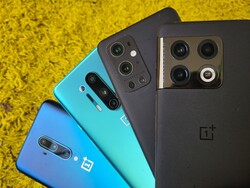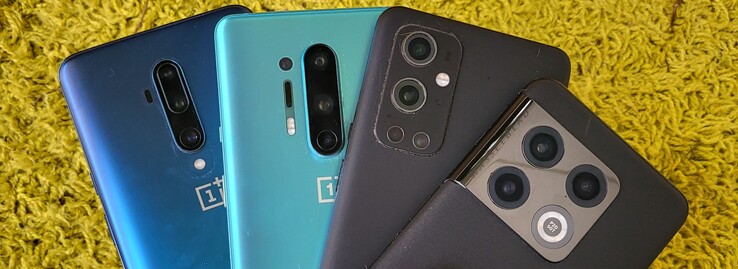Camera test - 4 years of smartphone development with a result that raises many doubts
In recent years, manufacturers have tried to improve the camera systems of their smartphone models continuously. Among other improvements, the amount of Megapixels in the camera sensors was increased drastically, and a resolution of 108 Megapixels is not rare anymore and has recently even reached the affordable midrange. In the near future, Samsung wants to equip its flagship smartphones with inhouse 200 Megapixel sensors and OmniVision has also introduced a camera sensor with a huge resolution of 16,384 x 12,288 pixels.
During their yearly new product introductions, the manufacturers try to outdo each other with announcements of new innovations and improvements, particular in the area of the cameras. We take a closer look at the development of the picture quality in the example of OnePlus smartphones. How much better are the cameras of a flagship smartphone from the year 2022 compared to the 4-year old ancestor?
Using various scenes and light situations, we take a closer look at the pictures taken with the OnePlus smartphones. The technical information of the built-in camera modules are summarized in the table below.
| OnePlus 10 Pro | OnePlus 9 Pro | OnePlus 8 Pro | OnePlus 7T Pro | |
|---|---|---|---|---|
| Back Camera Setup | 48 MP (IMX 789, f/1.8, OIS) | 48 MP (IMX 789, f/1.8, OIS) | 48 MP (IMX 689, f/1.78, OIS) | 48 MP (IMX586, 1,6 μm, f/1.6, OIS) |
| + 50 MP (f/2.2, ultrawide) | + 50 MP (f/2.2, ultrawide) | + 48 MP (f/2.2, wide-angle lens) | + 16 MP (ultrawide, f/2.2) | |
| + 8 MP (f/2.4, OIS, tele, 3,3x optical) | + 8 MP (f/2.4, OIS, tele, 3,3x optical) + 2 MP (f/2.4, monochrome) | + 8 MP (f/2.44, OIS, tele, 3x optical) + 5 MP ( f/2.4) | + 8 MP (tele, 1 μm, OIS, f/2.4, 3x optical) | |
| Front Camera Setup | 32 MP (f/2.2) | 16 MP (f/2.4) | 16 MP (f/2.45) | 16 MP (f/2.0) |
| Software Version | NE2213_11_A_12 | 11.0.7.1 | IN2025_11_C_11 | 11.0.7.1 |
| Model Year | 2022 | 2021 | 2020 | 2019 |
High-resolution main cameras have already been the standard in the high-end range for several years, even though the high resolutions aren't used by default. In the pixel binning process, the actual size of the separate pixels is increased via computation, allowing the sensor to capture significantly more light and correspondingly also more image information. All the smartphone models in this camera comparison use this route of image processing, so that the recordings don't necessarily correspond to the resolution of the camera sensors.
You can look at all the pictures in their original size by clicking on the corresponding tile in image comparison.
Recordings with the main camera of the OnePlus smartphones
In good light conditions, the picture quality of the four OnePlus smartphones is similarly convincing. While the camera modules branded as Hasselblad and the OnePlus 8 Pro often prefer a slightly cooler color reproduction, the 7T Pro is calibrated visibly warmer. On the other hand, the OnePlus 9 Pro offers the most realistic color reproduction, particularly when it concerns darker color tones.
Apart from the color accuracy, we also like the recordings of the 9 Pro the best, but it is only small nuances rather than grave differences that lead us to this decision. The noise levels of the OnePlus 7T Pro and OnePlus 8 Pro are slightly more pronounced than those of the 9th and 10th generation of the OnePlus flagships (see scene 4). We also notice a minimal advantage in the sharpness under less optimal light conditions. However, in the current Pro model, some of the colors are distorted, and the blue writing is reproduced as turquoise, for example.
The trends we saw also continue in our third scene. However, the OnePlus 10 Pro doesn't reveal any more details than the 7T Pro does. In this picture as well, the flagship from 2019 shows more accurate colors (such as the roof colors) than the current OnePlus smartphone. In the flower earth bag scene, the 7T Pro does surprisingly well. In this picture, we purposefully do not choose the focal point but just point the smartphone via point-and-shoot several times, letting it choose the focus itself. The center of the image, which is the area with the flower earth bags, is reproduced sharp and clear without the grass having any impact.
In the portrait mode (scene 1), the OnePlus 9 Pro and 10 Pro look very sharp, but also somewhat over-sharpened, and particularly the 2022 flagship exaggerates the artificial sharpening, while the 7T Pro and especially the 8 Pro deliver a softer image. The 2020er flagship is definitely and objectively too blurry, but it is a matter of taste, whether you prefer the picture of the 7T Pro or the OnePlus 10 Pro, since none of the four OnePlus smartphones offer more details. In terms of blurriness, all the OnePlus smartphones produce beautiful transitions.
Image Comparison
Choose a scene and navigate within the first image. One click changes the position on touchscreens. One click on the zoomed-in image opens the original in a new window. The first image shows the scaled photograph of the test device.
Scene 1 - DaylightScene 2 - DaylightScene 3 - DaylightScene 4 - DaylightIn terms of the quality of low-light photography, OnePlus made a huge jump with the 8 Pro compared to the 2019 generation. In our recordings, the 2020 flagship shows a similarly high quality as the two most current OnePlus models. In some aspects, we feel that the pictures of the OnePlus 8 Pro are even better. The OnePlus 7T Pro introduced in 2019 loses some points in this discipline. As good as the oldest flagship performs in daylight conditions, it is unable to keep up with the quality of the more current OnePlus models in low-light conditions. Particularly the image noise and reduced image sharpness stand out.
In our opinion, the positive surprise is the OnePlus 8 Pro. Pictures taken with the OnePlus smartphone from 2020 show a beautiful sharpness and good dynamic compared to a OnePlus 10 Pro. Particularly in our scene with the neon sign, the 9 Pro reproduces the illuminated sign best, also showing some minimal advantages in the sharpness compared to the OnePlus 8 Pro.
In dark surroundings, there isn't much that is right about the color reproduction of the OnePlus 10 Pro, even though it offers the best overall sharpness in the scene with the books (scene 1). Yellow color tones look more like pink here, and the color is also disappointing in scene 3. Overall, we would clearly prefer the OnePlus smartphone from 2020 over the current flagship in the royal discipline of low-light photography.
Image Comparison
Choose a scene and navigate within the first image. One click changes the position on touchscreens. One click on the zoomed-in image opens the original in a new window. The first image shows the scaled photograph of the test device.
Scene 1 - DarknessScene 2 - DarknessScene 3 - DarknessPictures taken with the ultrawide-angle cameras of the smartphones
Due to its deficits in the sensor resolution, the quality of the OnePlus 7T Pro ultrawide-angle lens drops visibly compared to the other three OnePlus smartphones in our generation comparison. In addition to the reduced details, some chromatic aberration as well as some slight graininess are noticeable in daylight. It is a bit surprising that the 10 Pro turns out even visibly worse than the OnePlus 8 Pro. We had already determined in our separate test of this year's flagship that a OnePlus 9 Pro would still be clearly the better choice as far as wide-angle photos are concerned.
The flagship of 2021 delivers the best results in daylight as well as at night, but well-illuminated scenes are reproduced almost just as sharp and rich in detail with the OnePlus 8 Pro. Particularly in low light, the pictures taken with the ultrawide-angle camera of the OnePlus 10 Pro deliver the least details and lowest dynamic.
Image Comparison
Choose a scene and navigate within the first image. One click changes the position on touchscreens. One click on the zoomed-in image opens the original in a new window. The first image shows the scaled photograph of the test device.
Scene 1 - DaylightScene 2 - DaylightScene 3 - DarknessScene 4 - DarknessZoom recordings with the OnePlus smartphones
Considering the small differences in the zoom recordings, we were unable to determine a clear winner, which really speaks for the three-year-old OnePlus 7T Pro. Neither in the dark nor during daylight were we able to see any major differences in the image sharpness or dynamic.
Image Comparison
Choose a scene and navigate within the first image. One click changes the position on touchscreens. One click on the zoomed-in image opens the original in a new window. The first image shows the scaled photograph of the test device.
3.3x Zoom - Daylight3.3x Zoom - Daylight10x Zoom - Daylight3.3x Zoom - Night10x Zoom - NightRecordings with the front cameras of the OnePlus smartphones
On the data sheet, the current 10 Pro flagship has an advantage compared to the OnePlus models from the years 2019 to 2021 due to its highly resolving front camera. While the OnePlus 9 Pro stands out with a very soft focus and the 8 Pro with an exaggerated color saturation, the 32-MP camera of the OnePlus 10 Pro produces sharp selfies with a high contrast. The 7T Pro slightly brightens the selfies and offers less artificial sharpening.
Overall, the selfie of the OnePlus 10 Pro offers the best balance, but we don't consider the front camera pictures of the 2019 flagship or the OnePlus 8 Pro to be much worse either.
Image Comparison
Choose a scene and navigate within the first image. One click changes the position on touchscreens. One click on the zoomed-in image opens the original in a new window. The first image shows the scaled photograph of the test device.
Verdict on the camera test of the smartphone generationens

It is difficult to give a general verdict in this comparison, since the evaluation of the photo quality and value in relation to the current sales price shows a high degree of subjectivity. But we are still sure about one thing: in an image comparison, only very few people would be able to point out those from the current OnePlus smartphone generation. This goes for the pictures taken during the day as well as in the dark. This conclusion then also raises some questions as to the extent of progress that manufacturers (can) still make in their smartphone cameras.
Taking the example of the last four OnePlus generations, we evaluated the development in the picture quality during the last few years. While the quintessence of this test probably cannot be applied to 100% to other manufacturers, our results still point out clearly that there is a lot of marketing in terms of smartphone cameras.
Those who aren't willing to spend a lot of money for the most current flagship from OnePlus will still be very well served with a OnePlus 8 Pro. If you don't place a particular emphasis on low-light recordings, you can also take similarly good pictures with a more than three-year-old OnePlus 7T Pro as a buyer of the OnePlus 10 Pro.
In very good light conditions, a three-year-old OnePlus 7T Pro isn't really any worse than a OnePlus 10 Pro from 2022 - but rather the opposite. And even in the royal discipline of low-light photography, the two-year-old OnePlus 8 Pro is still our favorite, although the 9 Pro isn't really any worse.
However, these statements only concern the image quality. Camera features such as 12-bit RAW or tilt shift, video recording in 8K or in UHD at 120 fps are only available in the two most current OnePlus generations. In terms of the camera software, the OnePlus 9 Pro and 10 Pro have a clear advantage.
Availability
Various versions of the current OnePlus 10 Pro are available for example from Amazon for about $880 to $900. The OnePlus 9 Pro, which currently costs about $800 from Amazon, and the OnePlus 8 Pro, which is available for about $600, might also be interesting in terms of their price-performance ratio.


 Deutsch
Deutsch English
English Español
Español Français
Français Italiano
Italiano Nederlands
Nederlands Polski
Polski Português
Português Русский
Русский Türkçe
Türkçe Svenska
Svenska Chinese
Chinese Magyar
Magyar










